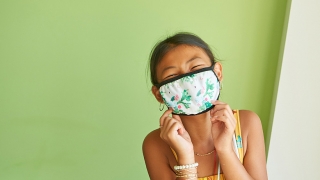Getting Your Child to Wear a Face Mask
Published on
Health Tip of the WeekPublished on
Health Tip of the Week Research has proven face coverings and physically distancing have a significant positive impact on transmission rates of respiratory viruses. As any parent can tell you, however, getting your child to obey rules they don't like or don't understand can be challenging. Susan Coffin, MD, MPH, an attending physician in the Division of Infectious Diseases at Children's Hospital of Philadelphia, offers some strategies to help your child better understand — and comply — with masking rules.
Research has proven face coverings and physically distancing have a significant positive impact on transmission rates of respiratory viruses. As any parent can tell you, however, getting your child to obey rules they don't like or don't understand can be challenging. Susan Coffin, MD, MPH, an attending physician in the Division of Infectious Diseases at Children's Hospital of Philadelphia, offers some strategies to help your child better understand — and comply — with masking rules.
Not all masks provide effective protection. All masks should have two layers of cloth that fit tightly over your nose and mouth. It is also important to wear your mask properly, covering both your mouth and nose.
Don't pull it down to sneeze, push it up to eat or drink or continually adjust it. Have your child talk, sing and jump up and down in their mask before leaving the house to ensure it is secure.


For younger kids, consider making a game out of who can wear their mask the longest without touching it. You can practice while taking a walk, going to the playground or the grocery store. Stuffed animals and dolls can also practice mask wearing! Remind them to put the mask back on when they forget. For younger children, many reminders may be needed.
Masks are not recommended for children younger than age 2. Instead, weigh your family’s risk level and keep very young children at home if necessary, especially when respiratory viruses are circulating widely.
Most kids are more willing to follow the rules when they have some choices. One easy choice is which mask to wear. Masks come in a variety of styles, patterns, fabrics and fits. Does your child prefer ear straps or a tie in the back? Which can they put on and take off without help? Compliment their mask choice: “I love your mask! Do you like mine?”
If your family has multiple cloth masks for each family member, make sure to regularly clean the mask (or masks) your child is more cooperative wearing. Ensure each mask fits your child properly and is not visibly soiled. Don't let siblings share masks between washings — it spreads germs faster from one to the other — even if they all live in the same house. If both of your kids love the same style/pattern/fabric mask, buy multiples and label them.
To help children remain compliant, talk to them about mask breaks and when it might be appropriate to take one. For example, if you’re running errands with your child, you can suggest a short mask break when you are outside and a safe distance away from other people.
No one wants to wear a smelly or damp mask. To better encourage compliance with mask wearing, ensure you regularly launder cloth masks and dispose of paper masks. Remember to remove any filters from the masks before throwing them in the wash and allow masks to dry completely before use.
For young children still developing language skills, face shields may be a viable alternative. With the clear shield, children can see and mimic mouth movements for sounds and letters as they learn. Face shields may also be helpful for deaf and hard-of-hearing children who rely on lip reading and facial cues to understand others around them.
Contributed by: Susan E. Coffin, MD, MPH
Are you looking for advice to keep your child healthy and happy? Do you have questions about common childhood illnesses and injuries? Subscribe to our Health Tips newsletter to receive health and wellness tips from the pediatric experts at Children's Hospital of Philadelphia, straight to your inbox. Read some recent tips.